| * Correspondence to: Minoru Yoneda, Bioscience Bldg. 502, Graduate School of Frontier Sciences, The University of Tokyo, Kashiwanoha 5-1-5, Kashiwa, Chiba 277-8562, Japan. E-mail: myoneda@k.u-tokyo.ac.jp Published online 27 March 2010 in J-STAGE (www.jstage.jst.go.jp) DOI: 10.1537/ase.091214 |
In the Japanese Archipelago, Pleistocene human fossils have been recovered mainly from calcareous caves and fissure sites, especially in the Ryukyu Islands of southern Japan, which are widely covered by limestone and where more than half of the reported Pleistocene human remains have been found (Matsu’ura, 1999; Matsu’ura and Kondo, 2000). Chronological investigations on these materials, the so-called ‘Palaeolithic hominid’ remains assigned to the Pleistocene, have recently been conducted using accelerator mass spectrometry (AMS) radiocarbon (14C) dating and fluorine analysis, and have concluded that many ‘Paleolithic hominid’ remains were derived from relatively young layers. Hijiridaki Cave in Oita Prefecture, for example, produced human remains which could be dated to 14 ka based on the occurrence of Palaeolithic micro-blade industry in the upper layers (Ogata, 1967). However, radiocarbon dating of human remains excavated in 1999 from the upper and lower layers placed these in the medieval period, suggesting the possibility that the original material previously recovered is of younger origin (Matsu’ura and Kondo, 2001a; Kondo and Matsu’ura, 2007). As another example, the ‘Mikkabi Man’ from Shizuoka Prefecture was originally assigned to the Late Pleistocene based on its co-occurrence with extinct mammals (Tanabe, 1962). However, three ‘Mikkabi Man’ remains were directly dated to 7500–9500 BP, corresponding to the Initial Jomon period (Matsu’ura and Kondo, 2001b). To date, only human remains from the Upper Layer of the Hamakita Negata site in Hamamatsu City, Shizuoka Prefecture have been confirmed to be from the Pleistocene by direct radiocarbon dating of the human parietal, occipital, and humerus pieces, which dated to 14050 ± 50, 14200 ± 50 and 13860 ± 50 BP, respectively (Kondo and Matsu’ura, 2005).
While the limestone regions of the Ryukyu Islands have produced a number of human remains assigned to the Pleistocene, chronological investigation with modern technology has produced few numerical dates directly derived from human remains. Since the 1960s, the Ryukyu Islands have attracted the attention of anthropologists because of the presence of Pleistocene fossils, which include human remains. Excavations initiated by Mr Seiho Oyama and collaborators investigated the Minatogawa fissure site on Okinawa Island from 1968 until 1974, and unearthed human skeletons from at least five individuals, which are still very important materials for the study of human evolution in East Asia (Suzuki and Hanihara, 1982; Baba and Narasaki, 1991; Kaifu, 2007). In addition to the Minatogawa materials, human remains, including a few controversial ones from the following sites, have so far been assigned to the Pleistocene: Yamashita-cho Cave 1, Tobaru, Kadabaru, Gohezu and Oyama caves on Okinawa Island; Shimojibaru Cave on Kume Island; Pinza-Abu Cave on Miyako Island (Figure 1). Recently, furthermore, excavations have been conducted at the sites of Minatogawa fissure and Hananda-Gama to investigate the Pleistocene human occupation of Okinawa Island (Gushikami-son Kyoiku-iinkai, 2002; Okinawa Prefectural Museum and Art Museum, 2009).
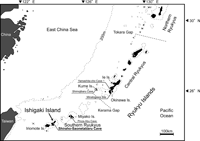 View Details | Figure 1. Human remains assigned to the Pleistocene found on the Ryukyu Islands. |
The numerical age determinations for Pleistocene human occupation in Okinawa do not rely on dating the human remains themselves, but on the dates of accompanying materials such as charcoal (Table 1). From Yamashita-cho Cave 1, which yielded infant femur and tibia, a radiocarbon age of 32100 ± 1000 BP on charcoal from the upper layer was obtained; this is frequently referred as one of the oldest dates of human occupation in Japan (Kobayashi et al., 1971; Takamiya et al., 1975a). In the case of Minatogawa, two radiocarbon dates of 18250 ± 650 and 16600 ± 300 BP on two chunks of charcoal recovered near human remains are interpreted as the period of human occupation there (Kobayashi et al., 1974; Suzuki and Hanihara, 1982). A uranium-series date measured by gamma ray spectrometry probably supports their great antiquity (19200 ± 1800 years ago; Yokoyama, 1992), although it has been repeatedly suggested that this method should be investigated in view of the high likelihood of contamination (Matsu’ura, 1999; Matsu’ura and Kondo, 2000). Furthermore, radiocarbon ages of 15200 ± 100 BP on crab shell from Shimojibaru Cave (personal communication, Y. Hasagawa; according to Matsu’ura, 1999) and of 25800 ± 900 and 26800 ± 1300 BP on charcoal from Pinza-Abu (Hamada, 1985) were reported as the dates of Pleistocene human remains from these caves. However, it is worth noting that sediments in calcareous fissures and caves are commonly secondary deposits with much disturbance, and the temporal relationship between measured materials and human remains are generally controversial (Matsu’ura, 1999; Matsu’ura and Kondo, 2000; Kondo and Matsu’ura, 2007). As far as we know, radiocarbon dating has not been applied to any Pleistocene human remains from the Ryukyu Islands.
Generally speaking, radiocarbon dating cannot easily be applied to human remains from tropical and sub-tropical regions because collagen, which is generally resistant to contamination and diagenetic effects, is readily degraded in these environments (Holmes et al., 2006). In exceptional cases, materials encapsulated by fine grains can show good preservation of collagen. In this study, we succeeded in extracting well-preserved collagen from human bones recovered from Shiraho-Saonetabaru Cave on Ishigaki Island and certified that some of these bones date to the Late Pleistocene according to the radiocarbon ages directly measured from human remains. These data are the first concrete direct evidence of human occupation of the Ryukyu Islands in the Late Pleistocene.
The Ryukyu Limestone of Pleistocene age overlies the crystalline schist of the Tomuru Formation and is distributed throughout the northern part of Shiraho, Ishigaki City, Okinawa Prefecture. Several limestone caves were formed at the boundary of the Ryukyu Limestone and the Tomuru Formation by underground streams running between these layers (Figure 2). In this region, Shiraho Cave was surveyed and excavated by the Research Group for Pleistocene Man in Okinawa (Nohara, 1996). In 2007 and 2008, five caves were surveyed as part of the consultation over the construction area of the new airport in the south of Mt Kara-dake. The survey was conducted by the Okinawa Caving Association using a surveying compass (LS-25, Ushikata Mfg. Co., Ltd.) with an accuracy of ± 3 cm. During the survey, human and mammalian remains were found at numerous points in caves, especially in the collapsed part of Shiraho-Saonetabaru Cave. This cave was tentatively named C1 Cave, having been previously recorded as Takayama-Abu Cave by Okinawa-ken Kyoiku-iinkai (1980). Excavations of fossil-bearing deposits were conducted three times (in May, August–September 2008, and July 2009).
 View Details | Figure 2. The location of Shiraho-Saonetabaru Cave on Ishigaki Island and the sampling points of human remains in the collapsed hall: (a) the fossil chamber, (b) the breccias chamber, (c) near stream, (d) the bat chamber, and (e) the human bone chamber. |
A collapsed hall with a narrow open space was found in Shiraho-Saonetabaru Cave between the Ryukyu Limestone and the Tomuru Formation, and extended 255 m in total length of the upper and lower parts (Figure 3). There is a stream through the Tomuru Formation in the lowest part of the collapsed hall. Limestone and crystalline schist breccias and sandy sediments were scattered on the floor of lower cave, 1 m above the stream. In the upper part of the cave, the floor is covered with muddy sediments and huge limestone breccias or flowstones. These sediments include human and mammalian remains. The human and animal remains reported in this paper were mainly found at the following points in the collapsed hall of Shiraho-Saonetabaru Cave (Table 2).
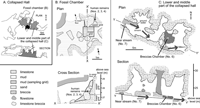 View Details | Figure 3. Excavation in the fossil chamber and the lower part of the collapsed hall in Shiraho-Saonetabaru Cave. |
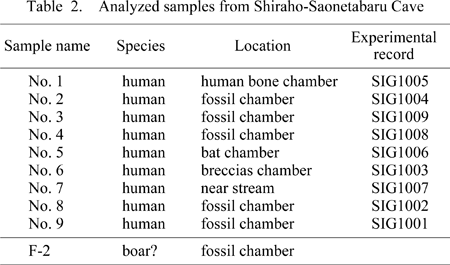
Fossil chamber (see Figure 2C, Figure 3B)
The fossil chamber is 3 m square × 2.5 m high, and is surrounded by huge limestone and flowstone breccias. In the direction from north-northeast to south-southwest, unconsolidated muddy sediments were accumulated on the northeast wall. Similar sediments were observed between the folding of flowstone covering large breccias in the northwest and southwest walls, and spaces between breccias. These muddy sediments mainly consisted of sticky mud which was dark reddish-brown in color, including boulder-to-pebble-sized limestone or flowstone breccias and pebble-to-granule-sized crystalline schist gravels. A large number of mammalian remains were recovered from these sediments.
In May 2008, three of the authors (S.N., Y.N., and H.Y.) excavated the fossil chamber. They set up two grids, upper and lower grids, on the fossil-containing sediments (see Figure 3B). The lower grid was set 0–1 m above the floor, describing a square on the surface measuring 1.2 m × 1.2 m, and the upper grid was set 1–2.5 m above the floor describing a rectangle on the surface measuring 1 m × 1.5 m. The thickness of the excavated sediments was approximately 50 cm at the deepest point. The wet weight of the excavated sediments taken from the lower and the upper grids for water sieving were 525 and 540 kg, respectively. Water sieving with 0.5 mm mesh was applied for those deposits to collect micro-faunal samples (Kawamura, 1992).
In this excavation, a piece of human cranium (Sample No. 2) was found from the bottom of the upper grid, at a depth of 50 cm from the surface, close to a huge limestone breccia, which was located in the horizontal position. A human lumbar vertebra (No. 3) and metatarsal (No. 4) were unearthed near this point. In addition, a fragment of human right fibula (No. 8), which probably fell from the section in the fossil chamber, was recovered in September 2008, and a piece of human frontal bone (No. 9) was taken from the exposed section of this chamber in July 2009 as well.
The sediments from the excavated grids and the folding of the flowstone at the northwest wall included mammalian remains. Because similar sediments including mammalian fossils were distributed in the NNE, NW, and SW parts of the fossil chamber, it is thought that this chamber was once filled with muddy sediments, most of which then ran off. The following observations suggest that these sediments, which had originally been distributed in different positions in the cave, probably accumulated in a short period because of rapid changes in the cave environment, such as water cycle: (1) there are no clear boundaries in the sediment; (2) there is a higher concentration of small mammalian remains in deeper parts; (3) the remains of medium-sized mammals are incomplete and fragmentated; and (4) various degrees of surface abrasion patterns of remains are observed nearby, suggesting secondary deposition of these materials.
Near stream (see Figure 2C, Figure 3C)
A stream runs through the lower part of the collapsed hall. A coarse-grained sand layer deposited about 1 m in depth is found in the western part of the lower cave. One of the authors (H.Y.) tested a trench about 20 cm deep, and found a human left parietal fragment (No. 7). No mammalian remains or artifacts were found. Shells of great green turban were found in the stream near this area.
Breccias chamber (see Figure 2C, Figure 3C)
There is a 3 m square chamber in the eastern part of the lower cave where many limestone breccias were scattered on the floor. The deposit was about 1 m in thickness. The left femur of a human (No. 6) was found beneath the breccias. Additionally, a sherd of pottery was found in this chamber.
Human bone chamber (see Figure 2C)
There is a small chamber slightly above the fossil chamber. In this chamber, there is a deposit of dark brown sandy mud and boulder-sized breccias are scattered around. A human cranium (No. 1, also recorded as cranium A) was found between the breccias on the surface. A pot of Shimotabaru type was also obtained in this chamber (Okinawa-kenritsu Maizo Bunka-zai Senta, 2009).
Bat chamber (see Figure 2C)
The chamber is located at about 10 m deep from the entrance of the cave, and is about 5 m wide × 1 m high. The floor was covered with a sand layer with limestone breccias. A human left parietal (No. 5) was found on the surface in the west corner of this chamber.
Gelatin from biogenic collagen was extracted from bones using an improved method of gelatinization (Longin, 1971; Yoneda et al., 2002; Yoneda et al., 2005). The gelatin yield, the carbon and nitrogen contents in extracted gelatin, and the atomic ratio of carbon and nitrogen were measured to evaluate the preservation of collagen (Ambrose, 1990, 1993; van Klinken, 1999).
Bone samples were taken using a disk saw and surface debris was removed by sandblasting with pre-burnt aluminum oxide powder, brushing and ultrasonic cleaning. After removing humic and fulvic acids by soaking in 0.2 M NaOH at 4°C for at least 12 hours, samples were crushed into a fine powder. Bone powder was sealed in cellulose tubes dissolved by 1.2 M hydrochloric acid to remove the inorganic bone fraction (hydroxyapatite) and humin in soil organic matter. The remaining organic matter was gelatinized in water adjusted to pH 3 at a temperature of 90°C overnight. Dissolved gelatin was separated from residual deposition by centrifugation, filtered with a glass microfiber filter (Whatman GF/F), and then freeze-dried. An additional purification step using ultrafiltration (VIVASPIN 20, 30000 MWCO, Sartorius) was applied for sample No. 5, because only this piece of bone was dark brown in color (Bronk Ramsey et al., 2004).
A 0.25 mg portion of lyophilized gelatin was analyzed for carbon and nitrogen content, and carbon isotopic ratio using an elemental analyzer (Carlo Erba NA1500TM) and an isotope ratio mass spectrometer (Finnigan MAT 252TM), respectively. These results were used to evaluate the preservation of collagen in extracted gelatin and to correct for kinetic fractionation of radiocarbon ratios (Stuiver and Polach, 1977).
For 14C analysis, 1.2–2.5 mg of collagen, containing about 0.5–1 mg of carbon, was oxidized to CO2 inside evacuated tubes with copper dioxide at a temperature of 850°C, and then CO2 was cryogenically purified in a vacuum system (Minagawa et al., 1984). Then, CO2 was reduced to graphite using hydrogen with iron powder catalysis for AMS (Kitagawa et al., 1993). The mixture of graphite and iron powder was measured for radiocarbon content by AMS at the University of Tokyo, MALT Laboratory (Matsuzaki et al., 2007). At least two standards were loaded with unknown samples contemporaneously, which usually consisted of the new oxalic acid (NBS RM-4990C) and IAEA-C6 (ANU sucrose). For small samples of less than 1 mg of carbon (No. 8), standards of similar weights were measured for possible correction.
The animal bone (F-2) was prepared and measured at Paleo Labo Co., Ltd. by using 1.5 SDH accelerator (Kobayashi et al., 2007). The pretreatment protocol applied at Paleo Labo used 0.1 M NaOH and 0.5 M HCl without a cellulose tube. The 13C/12C ratio measured by AMS was used to correct the fractionation.
Nine fragments of human remains were found in Shiraho-Saonetabaru Cave. These consist of a cranial vault, a right parietal, two left parietals, a frontal bone, a left femur, a first lumbar vertebra, a right fibula, and a right metatarsal.
No. 1: cranium A from the human bone chamber (Figure 4)
 View Details | Figure 4. Human sample No. 1 (cranial vault), age: 175 ± 56 BP. |
Sample No. 1 is a well-preserved cranial vault. The developed glabella region and external occipital protuberance suggest that cranium A is from a male. The main sutures are mostly open exocranially, but closed endocranially. The condition of suture closure indicates cranium A is from a person aged in their thirties–forties. The cranial index (M8(139)/M1(191): 72.8) indicates dolichocrany.
No. 2: cranium B from the fossil chamber (Figure 5)
 View Details | Figure 5. Human sample No. 2 (right parietal), age: 20416 ± 113 BP. |
Sample No. 2 is a moderately mineralized thick (8 mm at bregma) right parietal. Coronal and sagittal sutures are mostly open both endocranially and exocranially. From these morphological features, we assessed this cranium B to be from an adult (20s–early 30s) male.
No. 3: lumbar vertebra from the fossil chamber (Figure 6)
 View Details | Figure 6. Human sample No. 3 (lumbar vertebra), age was not determined. |
Sample No. 3 is a sturdy first lumbar vertebra of an adult male. A remarkable osteophyte can be recognized on the vertebral body. Signs of osteoarthritis can also be recognized on the articular surface of the intervertebral joint.
No. 4: metatarsal from the fossil chamber (Figure 7)
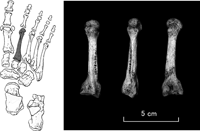 View Details | Figure 7. Human sample No. 4 (right second metatarsal), age: 18752 ± 100 BP. |
Sample No. 4 is the right second metatarsal of an adult, sex unknown.
No. 5: cranium from the bat chamber (Figure 8)
 View Details | Figure 8. Human sample No. 5 (left parietal), age: 998 ± 61 BP. |
Sample No. 5 is a moderately mineralized thick (8 mm at bregma) left parietal. Suture closure shows progression only at a part of internal lamina of coronal suture. We estimated this cranium to be from an adult (20s–early 30s) male.
No. 6: femur from the breccias chamber (Figure 9)
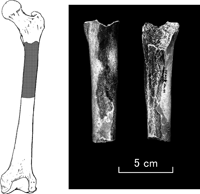 View Details | Figure 9. Human sample No. 6 (left femur), age: 2317 ± 36 BP. |
Sample No. 6 is the proximal part of an adult left femur, sex unknown. This femur is characterized by weak gluteal tuberosity, unclear pectineal line, and mineralized thick compact bone.
No. 7: cranium near stream (Figure 10)
 View Details | Figure 10. Human sample No. 7 (left parietal), age was not determined. |
Sample No. 7 is an adult left parietal, sex unknown. The darker color of this cranium shows that the nature of the soil surrounding this cranium might have been different from that surrounding the other samples.
No. 8: fibula from the fossil chamber (Figure 11)
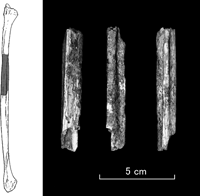 View Details | Figure 11. Human sample No. 8 (right fibula), age: 15751 ± 421 BP. |
Sample No. 8 is the proximal part of an adult right fibula. The thick compact bone indicates that this fibula is from a male.
No. 9: cranium from the fossil chamber (Figure 12)
 View Details | Figure 12. Human sample No. 9 (frontal), age was not determined. The exact part of fragment is not identified. |
Sample No. 9 is an adult frontal bone, sex unknown. Mineralization of this cranium is poor.
The results of morphological observations of these nine fragments of human remains are summarized in Table 3. We cannot connect any of these cranial fragments with each other. Considering the elements, location, sex and age assignments, and 14C dating, we estimated that the human remains from Shiraho-Saonetabaru Cave could consist of at least six individuals.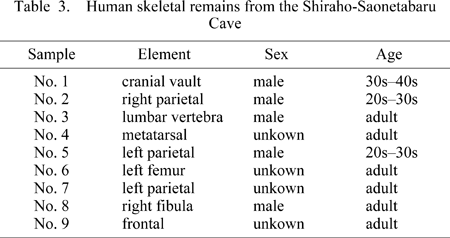
All bone specimens investigated in this study contained some gelatin (Table 4). Two pieces of bone from sample No. 6 were submitted for pretreatments and measurements to confirm the reproducibility of experiments. However, samples Nos. 3, 7, and 9 did not yield sufficient gelatin for radiocarbon dating and were not submitted for measurements. Carbon/nitrogen atomic ratios (C/N ratios) in gelatin are generally used to evaluate the preservation state of collagen (DeNiro, 1985). Eight samples from six human samples (Nos. 1, 2, 4, 5, 6, and 8) and an animal bone showed C/N ratios similar to the value observed for modern animals (2.9–3.6). Furthermore, the carbon (%C) and nitrogen (%N) contents of gelatin were more than 32% and 12%, respectively (see Table 4), exceeding the minimum criteria of 13% C and 4.8% N for well-preserved archaeological bones (Ambrose, 1990, 1993; van Klinken, 1999). Hence, it is likely that gelatin extracted from these seven samples mainly derived from well-preserved collagen.
Gelatin yield from bone could be another criterion for collagen preservation. Although Ambrose (1990) reported a value of 3.5% yield of gelatin for bone materials from Africa and North America, our results showed lower yields of between 0.1 and 5.1% in this study. According to this criterion, only two human samples (Nos. 5 and 6) indicated good preservation status. However, van Klinken (1999) re-evaluated this criterion with gelatin yield based on data from temperate Europe, suggesting that some samples with yield less than 1% contained genuine collagen. Gelatin yields from samples Nos. 1, 2, and 4 were 2.7, 0.9, and 1.6%, respectively, suggesting they might not have suffered serious contamination and/or degradation. On the other hand, human sample No. 8 dated to 16 ka BP and this has to be treated as a tentative result because of its lower yield.
Table 5 shows the results of isotope analyses including δ13C and radiocarbon ages. Duplicated extraction and measurements on sample No. 6 exhibit an excellent agreement both in δ13C and radiocarbon dates. Among these well-preserved samples (Nos. 1, 2, 4, 5, and 6), human samples Nos. 2 and 4 dated to 20416 ± 113 and 18752 ± 100 BP, clearly assigned to the Late Pleistocene. Although human sample No. 8 had a lower gelatin yield and was measured for radiocarbon at half the typical amount of graphite, it was dated to 15751 ± 421 BP. The animal bone prepared and measured independently produced a radiocarbon date of 12090 ± 37 BP, although this had a low yield of gelatin as well. As these all samples were derived from the fossil chamber in the collapsed hall, it is highly possible that the sediments in the fossil chamber contain fossilized materials mainly derived from the Late Pleistocene.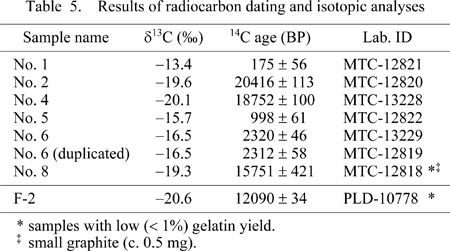
On the other hand, younger radiocarbon dates of 175 ± 56, 998 ± 61, 2317 ± 36 BP (weighted average with T of 0.01; Ward and Wilson, 1978) were obtained for three human remains from the outside of the fossil chamber (Nos. 1, 5, and 6, respectively). Because their stable isotopic ratios ranged between −13.4 and 16.5‰, which are significantly higher values than generally found for terrestrial organisms, i.e. around −25‰, the marine reservoir effect could make their apparent radiocarbon ages several hundreds older (Yoneda et al., 2000, 2007). Even with the disturbance of carbon derived from the marine reservoir, sample No. 1 was derived from modern times and Nos. 5 and 6 were derived from the Sakishima-Neolithic period.
Among radiocarbon ages of six human and one animal bones from Shiraho-Saonetabaru Cave, the radiocarbon dates of 20 and 19 ka BP for human Nos. 2 and 4 suggest that these individuals date to the Pleistocene. Furthermore, human fibula No. 8, with an age of 16 ka BP probably should be assigned to the Pleistocene as well. The radiocarbon ages reported from Shiraho-Saonetabaru Cave are clearly older than the dates from the Upper Layer of the Hamakita Negata site (14050 ± 50, 14200 ± 50, and 13860 ± 50 BP for parietal, occipital, and humerus; Kondo and Matsu’ura, 2005), the oldest radiocarbon ages for Japanese human remains previously reported. Hence, these materials from Ishigaki Island are the oldest directly dated human skeletons in Japan, although some reservoir effects by 14C-depleted carbon from marine and calcareous environments might make those dates a few hundred years older.
From the caves and fissure sites on the Ryukyu Islands, a number of human remains have been assigned to the Pleistocene, including ‘Minatogawa Man’ (Suzuki and Hanihara, 1982). However, in spite of the chronological significance, there are no critically dated human remains because of a lack of archaeological context (i.e. surface collection) or the complicated stratigraphic conditions of fissure and cave sites (Matsu’ura, 1999; Matsu’ura and Kondo, 2000; Kondo and Matsu’ura, 2007). In this study we succeeded in obtaining radiocarbon dates for human remains which are clearly assigned to the Late Pleistocene and support the human occupation of the Ryukyu Islands in this period (at least between 16 and 20 ka BP).
As far as we know, no archaeological evidence of Pleistocene human occupation has been reported from Ishigaki Island, although human remains from Pinza-Abu Cave on Miyako Island are well known in this region (Sakura, 1985). It is highly possible that additional well-preserved human remains, hopefully including complete skulls and entire bodies, can be recovered from Shiraho-Saonetabaru Cave and the surrounding limestone sediments bearing Pleistocene fossils. We only investigated fragmented specimens of Pleistocene human in this study. It is clear that additional samples from this region would result in great progress in understanding the evolution of modern humans in East Asia, as well as the origin of Jomon populations, particularly if they yielded radiometric dates.
Although Sondaar (2000) suggested that Minatogawa Man and other humans used boats to inhabit island regions, archaeological evidence of trans-oceanic dispersal has not been found. Human remains dating to 16 and 20 ka BP in this study correspond to the Last Glacial Maximum. More chronological and archaeological research might throw light on the detailed history of human dispersal as well as the human adaptation to marine resources in this region. Furthermore, more precise dating on extinct cervids, including Cervus astylodon and Muntiacinae species reported from the Ryukyu Islands (Hasegawa, 1980), must be undertaken to investigate the relationship between the timing of human dispersal and their impact on insular environments.
On Tanegashima Island, located north of the Okinawa Islands, a rich industry of Palaeolithic artifacts has been found, clearly suggesting that Palaeolithic cultures reached this island (Miyata, 2005; Kuwahata, 2006). In addition, some materials from Tokunoshima Island in the northern part of the Ryukyus also produced materials assigned to the Palaeolithic (Yotsumoto and Ito, 2002). However, the Okinawa Islands and southern regions have not produced significant examples of Palaeolithic stone tool technology, the controversial exceptions being from Yamashita-cho Cave 1 (Takamiya et al., 1975b; Oda, 2003) and Kadabaru Cave (Oda, 2007). The scattered stone tools in the Ryukyu Islands are in striking contrast to the abundance of human fossils assigned to Pleistocene. Because the contemporaneousness of human fossils and dated materials are a matter of great debate, the existence of a Palaeolithic stone tool industry in this region should be investigated by excavation of Shiraho-Saonetabaru Cave and the surrounding region, where Pleistocene human occupation is clearly evident.
Up to now, Palaeolithic artifacts and in situ evidence of human habitation have not been recognized in Shiraho-Saonetabaru Cave. This study suggests that sediments bearing Pleistocene human fossils are still preserved in and around this cave. Hence, it is important to make careful and intensive excavations of the sediments in this region in order to find Palaeolithic (Pre-Jomon) artifacts with chronological information. It is strongly expected that further corroborations between anthropologists, archaeologists and speleologists will illustrate not only the Palaeolithic culture of Okinawa, which is relatively unknown today, but also modern human evolution in East Asia.
We express our sincere gratitude to Hiromi Kurosu of Kyoto University, Motomasa Namiki, Mariko Ito, and Mayu Tsuchimoto of Aichi University of Education, Hisao Tamura and Masaru Tonohata of the Okinawa Caving Association for their assistance with field research, and particularly to Yoshinari Kawamura of Aichi University of Education for his useful advice. Noah V. Honch of Bristol University kindly provided useful comments and language corrections. We appreciate collaboration with SI SCIENCE Co., Ltd. and Paleolab Co., Ltd. for some measurements. This work was partially supported by the Grants-in-Aid for Scientific Research (Nos. 17107006, 20255007, 20370095, 20570227) from the Japanese Society for the Promotion of Science.
|